The Brazilian Whiteknee Tarantula (Acanthoscurria geniculata) is a New World terrestrial tarantula species that is native to the Amazon basin of Nothern Brazil. They’re large spiders that can have a leg span of over 8 inches.
Tarantulas have gained popularity over the years as fascinating pets with many options available to own. One of the most popular options is the Brazilian Whiteknee. It’s truly an eye-catching species not only due to its large size but also due to its striking coloration.
It has a black body & legs with striking white banding on the legs. These giant tarantulas are easily recognized and are known for their dramatic eating habits.
If you’re considering adding this fantastic species to your collection, here’s everything you need to know about them!
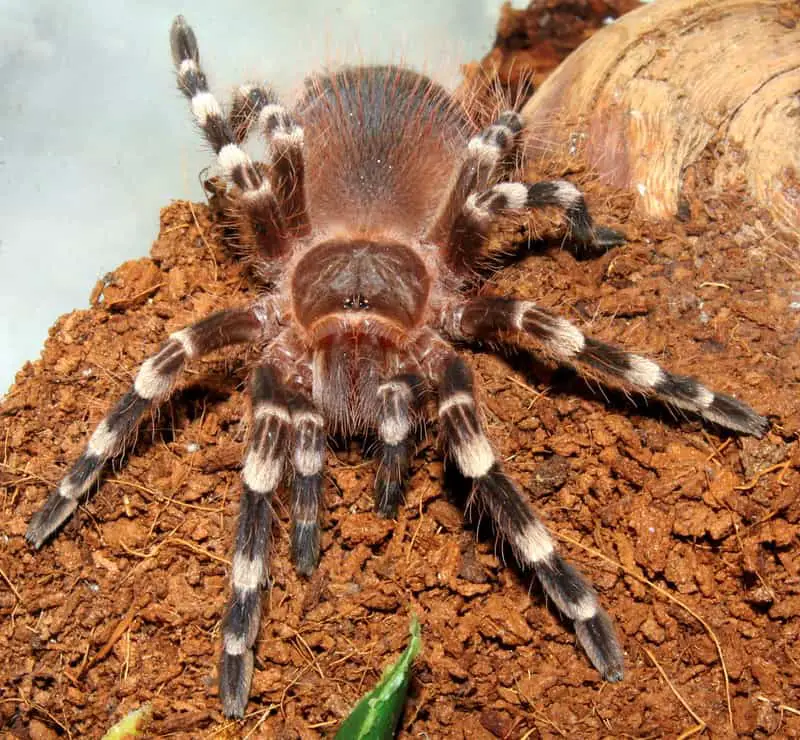
Brazilian Whiteknee Tarantula Care Sheet
| Name of species | Acanthoscurria geniculata |
| Family | Theraphosidae |
| Experience level | Beginner |
| Type | Terrestrial |
| Temperature requirement | 75-80 degrees Fahrenheit |
| Humidity | 65 to 75% |
| Temperament | Docile, nervous, can be defensive |
| Color | Black body with red hairs and black legs with white banding |
| Native location | Brazil |
| Lifespan | Females: 20 years male: 4 years |
| Growth rate | Fast |
| Urticating hairs | Yes |
| Size | Body length: 3.5” Diagonal leg span: 8.25” |
| Diet | Insects: crickets, roaches, worms, etc |
| Minimum tank size | 10-15 gallon tank |
Brazilian Whiteknee Tarantula Overview
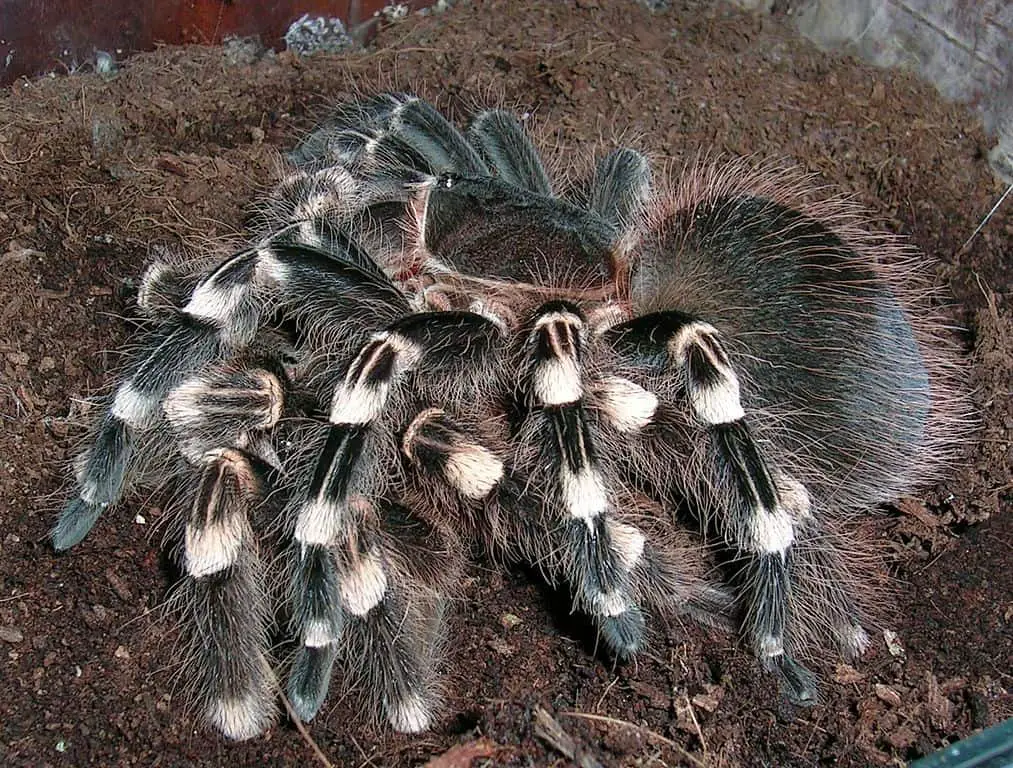
The Brazilian Whiteknee is scientifically known as the Acanthoscurria geniculata. As a New World species, they have urticating hairs which they use to defend themselves from predators.
Since they are terrestrial spiders, these animals spend their lives on the ground and have 4-6” burrows as living quarters.
With over 800 recognized species of spiders around the world, it can be confusing to keep them all straight.
Luckily, the Brazilian Whiteknee Tarantula is easy to recognize thanks to its large size and its unique white-banded legs.
Appearance & Variants
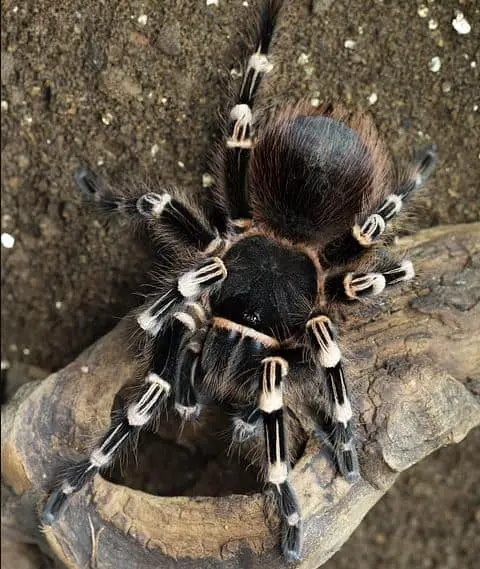
The Brazilian Whiteknee Tarantula gives itself away with its name. These striking spiders have black bodies with red hairs and long, black legs with white banding. When first born, these guys come out as brown but as they grow, they begin to show their adult colors around 1-2 years.
The female is larger than the male, not only in length, but they’re also much thicker.
With a leg span of up to 8.25 inches, this is one of the larger tarantula species.
Price
A popular species of tarantula, the Brazilian Whiteknee tarantula is readily available through most online exotic or reptile breeders or local pet stores.
The average cost of a sling, is anywhere from 40-150 dollars, making them a relatively budget-friendly pet.
As with all new pets, you will also need to buy supplies for your new spider. You’ll need an appropriately sized enclosure to fit your growing spider, substrate (bedding), a water and food dish, a hide, and of course, food! These are all relatively inexpensive items and can easily be found at your local pet store or online.
Behavior & Temperament
The Brazilian Whiteknee Tarantula is quite skittish and will run from a fight rather than stand its ground.
Rarely will they do a threat pose (front legs raised up in warning) but they can fling off urticating hairs when running away. These urticating hairs are typically not a threat to humans unless they end up in your eyes or other sensitive spots.
These tarantulas are very prey aggressive though and you should keep your hands far away when they come hunting for dinner. In their feeding frenzy, they might not be able to distinguish between your hand and their prey.
Brazilian Whiteknee Tarantulas are venomous but their venom is not as potent as that of some other species. It’s typically not very dangerous to people. If you are bitten, you will feel a bit of discomfort but it’s nothing to worry about unless you are allergic.
As solitary creatures, Brazilians will spend most of their time above the ground as adults and make for great show spiders.
Caring for a Brazilian Whiteknee Tarantula
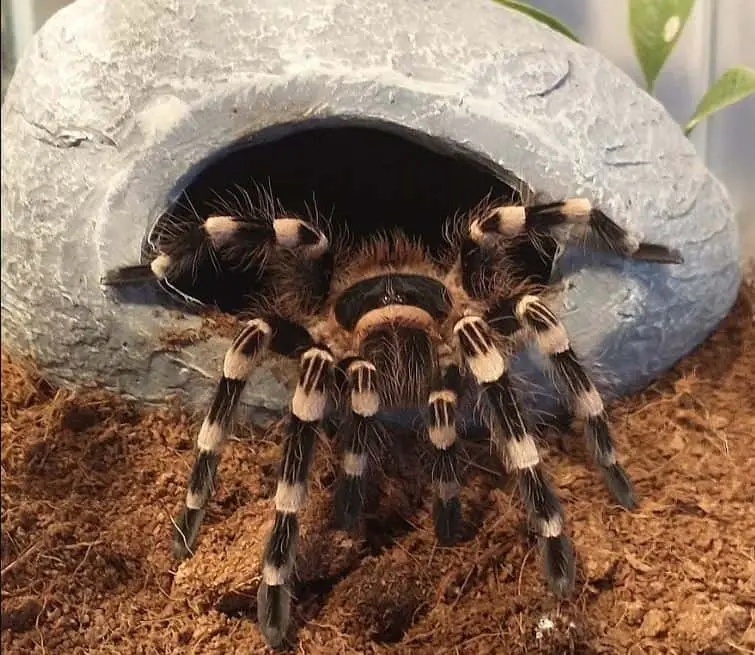
Tank size
Baby spiders can be brought (or delivered) home in a small container with holes poked in the top for breathing room. They’ll be quite tiny and won’t need much room until they begin to mature.
Once your spider begins to molt and mature, they’ll need to be moved into appropriate sized enclosures, eventually moving into their permanent home of a 10-15 gallon tank. These are larger than average tarantulas and will need the legroom!
However, even though they’re a large species, a tank larger than 10 to 15 gallons is not necessary. You might think that they’d enjoy a larger cage, but these animals are quite lazy. They do not enjoy wasting energy unnecessarily. They only really move when absolutely necessary. In fact, too large of a terrarium can actually be a bad thing because it can make it more difficult for them to catch their food.
Substrate
Brazilian Whiteknees spend their lives on the ground and create burrows to sleep in, give birth to their young, and catch prey. You’ll need to provide at least 6 inches of substrate. Good substrate materials include coco fiber, peat moss, vermiculite, corn cob granules, and cypress mulch. Sphagnum Peat Moss is also great to include in their enclosure since it’s great at retaining moisture which can increase the humidity level.
As Brazilians mature, they will spend most of their time in the open, but will still need a space to escape to. Change substrate out every 1-2 months to keep their enclosures healthy.
Humidity & Temperature
Brazilian Whiteknees thrive in a humid, warm temperature. Keep their tanks at 65-75% humidity and the temperature between 75-80 degrees Fahrenheit.
As these spiders come from Brazil, they’ll enjoy a humid enclosure which can be achieved by misting their enclosure occasionally. Alternatively, you can give them an oversized water bowl. The evaporation will increase the moisture in the air, raising the humidity levels.
Foliage & Tank Decoration
While slings and young spiderlings will burrow into their substrate, most adult Brazilians will enjoy strutting about their enclosures. Provide them with a log home or some sort of structure to hide in and a water and food dish.
Molting
All tarantula species molt and the Brazilian Whiteknee is no exception. Since this is a fast-growing spider, they will molt quite often, especially when they’re young. When they’re about to molt they typically will not want to eat or drink. The molting process is quite an intense and stressful time for your eight-legged friend, so try not to disturb them.
After they’ve molted they will not eat for a while until their fangs have hardened enough.
Social
Some tarantulas, like the Socotra Island Blue Baboon, are capable of communal living. However, this is not the case for the Brazilian Whiteknee. This is strictly a solitary species and you should not house more than one of them together. They only meet when they’re about to breed.
Feeding your Brazilian Whiteknee Tarantula
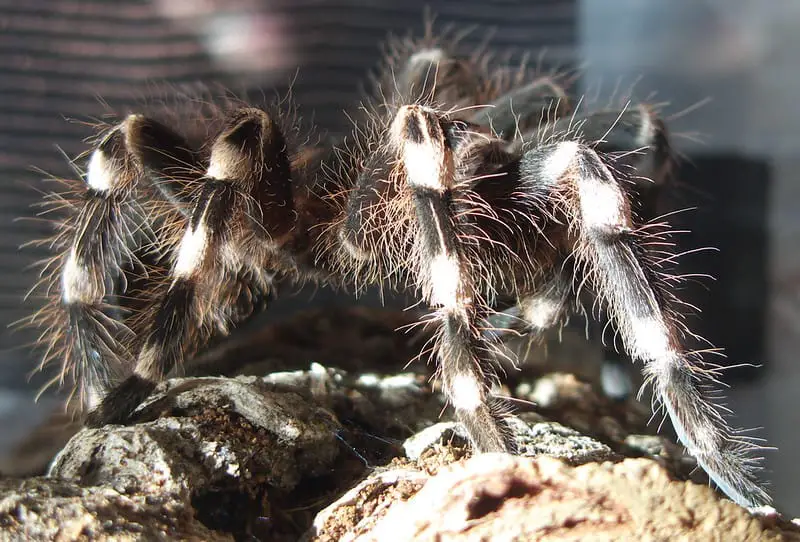
Brazilian Whiteknee tarantulas are known for their ferocious appetite. They can live their entire lives happily on a diet that consists entirely of insects.
As spiderlings, they should be fed small crickets or roaches about twice a week. Pre-kill these insects to ensure that they do not harm the sling.
Once they become juveniles they can start to eat medium-sized crickets but make sure that the prey you’re feeding them is not bigger than the spider’s abdomen.
Adults can eat quite a lot but should only be fed once every 7 to 14 days. Every spider has a different size and activity level, so the amount of food they need varies. Keep an eye on the abdomen, if you notice that it’s getting bigger you’re overfeeding them. On the other hand, if it’s getting smaller, you’re likely not giving them enough food.
Gut-loading the insects is something that some owners do to ensure that the spider gets all the nutrients it needs.
As far as drinking goes, tarantulas only drink water. Give them a shallow water bowl that contains fresh water at all times so that they can hydrate themselves when they need to.
Health & Lifespan
Another great reason that tarantulas have gained popularity is that they’re easy to care for and live long lives if properly cared for. The Brazilian Whiteknee Tarantula typically has a lifespan of around 20 years for females and 4 years for males.
In captivity, the only real danger to them is parasites and mites that can be introduced to their habitat, mold/bacterial growth, and falls. As long as you prevent these threats and give them a good enclosure with good food they’ll be able to thrive.
Quick facts about the Brazilian Whiteknee Tarantula
- This species is known for its dramatic eating habits and quickly pounce on prey. They’ll even roll over in anticipation of a meal!
- The Brazilian is an aggressive predator as well and will tackle prey much larger than themselves!
- Due to their aggressive appetites, Whiteknees are prone to obesity. Be sure to feed the recommended amount and save tasty treats such as mice once or twice a year.
Final words
The Brazilian Whiteknee Tarantula is an easy-to-care-for species of spider and perfect for first-time owners. Their unique coloring has made them popular along with their docile natures. Though aggressive when eating, it can be fascinating to watch them take down their prey!
As long as you provide your tarantula with an appropriate size enclosure with proper substrate and a humid, warm temperature, they’ll be a very happy pet.
Adult Brazilians enjoy being in the open as they mature and you’ll often see them sitting out, making for great show pets. With the proper research and realizing that tarantulas are not scary, you’ll have the coolest pet on the block.
- How Long Do American Eskimo Dogs Live? Important Factors and Care Tips - September 29, 2023
- Do American Bulldogs Need Grooming? Essential Tips and Care Guidelines - September 29, 2023
- Do Bengal Cats Enjoy Playing? Essential Tips for Keeping Them Active - September 29, 2023